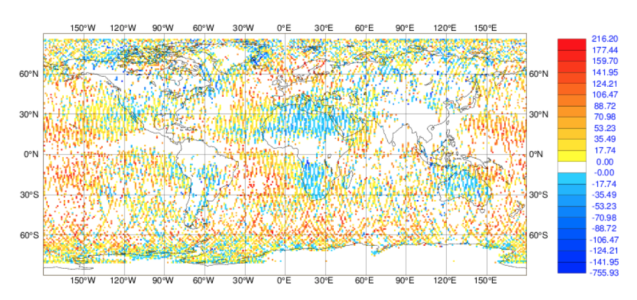Assimilation of lidar observations of aerosols for climate modelling and NWP

The objective of the Aeolus/EarthCARE Aerosol Assimilation Studies (A3S) project was to allow assimilation of the Aeolus L2A lidar backscatter data, also paving the way for the assimilation of EarthCARE products. Since the Aeolus and EarthCARE missions were not yet launched at the time of the study, demonstration datasets based on model data (MOCAGE model for the aerosols and the IFS for the clouds) and a one-day dataset based on CALIPSO data (reprocessed at the UV wavelength and with the Aeolus orbit data) was created. Technical developments were undertaken at ECMWF to extend the observation operation for lidar backscatter which had been used for CALIPSO data and to enable the use of different datasets. In particular, the backscatter lidar operator was adapted to the 355 nm wavelength, including the tangent linear and adjoint routines. An operator for extinction was also developed, but is not yet tested. It is expected that the aerosol extinction product from Aeolus will not be of high enough quality for assimilation. The existing data quality control and screening was adapted for the Aeolus/EarthCARE products. The demonstration datasets were encoded into the Observation Data Base (ODB) which allowed inclusion in the IFS’s 4D-VAR system.
The final report provides a detailed description of the aerosol model, observation operator, aerosol analysis and structure of ECMWF’s incremental 4D-Var. Functional tests of the assimilation system are presented and discussed. These tests showed that it is technically possible to assimilate Aeolus L2A data into the ECMWF system.
Several 4D-Var assimilation experiments were performed to assess the assimilation of the L2A lidar backscatter demonstration datasets. From a technical point of view the assimilation of L2A backscatter data was completely successful. From a scientific point of view, however, some issues were highlighted. In particular, the MOCAGE aerosol + IFS cloud was shown to have large, possibly unrealistic values of low level/low backscatter clouds which were not screened by the cloud screening based on thresholds on height and backscatter values. Experiments were also conducted with the one-day L2A demonstration dataset derived from CALIPSO. These experiments showed the technical feasibility of the assimilation of L2A backscatter data and fewer problems for the clouds screening. The impact of the error assumptions on the L2A data was also investigated, showing a large reduction in bias with a corresponding increase in standard deviation when the reported errors were downscaled. This indicates an imbalance in the error assumptions for the background and the observations. When using the native errors from the L2A product, better results were achieved. Further investigation into the errors is needed.
Finally, verification using independent datasets from AERONET was also performed. Two experiments including the L2A aerosol-only demonstration dataset with and without MODIS data were compared. The experiment with the L2A data only is of comparable quality to the experiment which includes both L2A and MODIS data. While it is not possible to draw conclusions on what impact the actual L2A data will have, due to the use of synthetic datasets, it is nonetheless encouraging that the L2A synthetic data have a positive impact on the analysis. In view of the recent launch of the Aeolus satellite, when the actual L2A data will become available it will be possible to apply all the tools developed in A3S and investigate the impact of this type of observations on the aerosol analysis and forecast.
